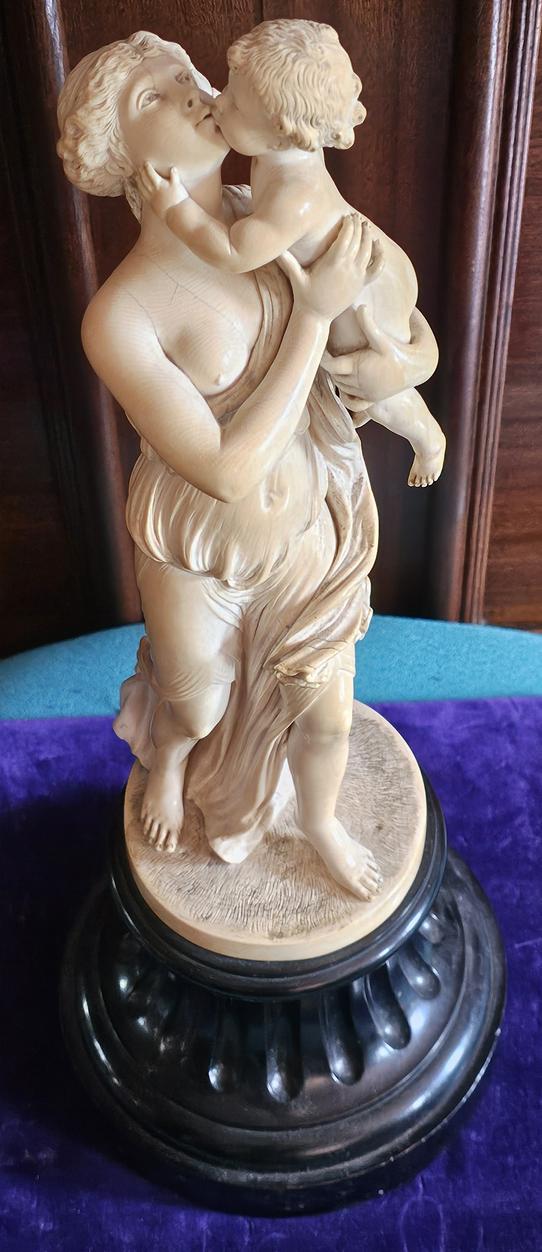Dear Jon, I’m requesting help regarding this very old ivory statue that has been handed down in my family for five generations that I’m sure of, and possibly even longer. As you can see it is in a family picture dated 1921. It stands 18 inches tall. It is a beautiful piece, but I really have no use for it. Unfortunately, my daughter doesn’t want it either. I would like to sell it. Could you tell me who, or where I may sell it and may I request the value of it as well. It has to have some value due to its age. Thank you in advance.
Margaret
Each month I receive several inquiries regarding art and antiques produced from ivory. I’ve been putting off addressing the legality of the sale and possession of ivory for some time. Now I feel I must write an article to explain the “ivory” situation in the United States. Over the years, ivory has been used in everything from Russian and English miniatures to fine Chinese carvings. What was once a thing of beauty is now an item that reflects concern for the world’s endangered species. The first thing I want to make clear is that fine arts and antiques composed of ivory that are already here in the United States can be sold domestically and exported only if there is documentation that verifies the ivory was harvested prior to 1976, or that it was imported before that year. 1976 is when the Convention in International Trade in Endangered Species went into effect. The key word here is documentation. You must have the necessary paperwork to legally sell ivory. Most ivory in private possession is undocumented. This mandate makes it illegal to import any item containing African elephant ivory for commercial purposes. There are, however, a few exceptions.
1) The item is accompanied by a document from the exporting country attesting it was acquired before 1976 by the current or the previous owner.
2) The ivory has not been bought or sold since February 25, 2014. Once in the United States, this ivory cannot be subsequently bought or sold.
3) Elephant ivory can be sold within a state only if accompanied by CITES documents attesting the ivory was imported prior to 1975.
4) The ivory has to pass the hundred-year-old test. A special certified appraiser of ivory can be hired, at great expense, to examine and certify your ivory.
5) If the ivory was imported after 1982, it must be proven the ivory came through one of thirteen ports specifically designated for antiques of this type. The other possibility is that you must prove the item was manufactured in the United States from legally imported ivory.
6) In some states, not New York or New Jersey, if the items are less than 10% ivory in volume and made prior to 1947, they can legally be sold. Florida is one state that does allow this.
As you can surmise, a great deal of red tape is required to legally sell ivory, and yes, substantial monetary penalties for violations, along with confiscation of the ivory is possible. The reasons behind the outlawing of ivory are that the elephant and rhinoceros’ populations across Africa and Asia are moving towards extinction. These animals are being slaughtered at an alarming rate to meet the demand for ivory. In my opinion, with all the federal and state laws surrounding the sale of ivory, my best advice is to avoid any involvement in the buying and selling of ivory. It is impossible for me to place a value on your ivory statue for the reasons I’ve spelled out. Unless you have the required documentation which you do not, your item cannot be legally sold or purchased. Anyone purchasing ivory is also in violation of the law. As beautiful as your statue is, and it is top quality, it is unable to be legally sold or purchased. For more information, please check the U.S. Fish and Wildlife Service Endangered Species Act Overview. You only other option is to donate your ivory to the U.S. Fish & Wildlife Service. The USFWS Office of Law Enforcement’s National Wildlife Repository in Commerce City, Colorado, accepts these donations. The U.S. Fish & Wildlife Service uses donated items to educate the public about animal conservation and the ivory trade. Thank you for submitting this important question.


You must be logged in to post a comment Login